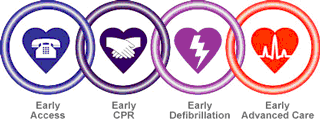Why are we needed?
Each year 300,000 people in the UK suffer a heart attack.
85% of people who have a heart attack have the potential to survive if basic life support is received soon enough.
Every minute without basic life support reduces the chance of survival by 10%
In the event of a cardiac arrest, without early intervention and defibrillation the chances of long term survival decline by as much as 10% per minute. In a largely rural county, First Responders are valuable links in the 'Chain of Survival'.
As First Responders are based within the community, they can attend the scene of an emergency very quickly, often arriving within the first three or four minutes. The Community First Responders can then begin vital life saving first aid before the Ambulance arrives, further increasing the patient's chance of survival.
In an ideal world, there would be an Ambulance available on every street corner in each town or in every village. This is not the case, and is why First Responders can make such a difference in their communities, especially in rural areas.
The Chain of Survival
The Chain of Survival was introduced in 1987, after a study in Seattle, USA. The study aimed to increase the survivability of victims of an out-of-hospital sudden cardiac arrest (when the heart stops beating).
Dr Richard Cummins, from Seattle, discovered that if a series of events took place in a set sequence, a heart attack victim has a greater chance of survival. These events are known as the "Chain of Survival".

We know that in many medical emergencies and after accidents, people can die within the first few minutes. We also know that if certain simple but critical interventions can be performed within those first few minutes that life can be saved and disability reduced. This is especially the case for heart attacks, choking and injuries that have caused someone to lose consciousness.
When the first three links of the 'Chain of Survival' are put into practise, by Community First Responder teams, it has been shown that survival rates can be improved to between 25-40%.
In recent years, advances in technology have been made, and many interventions which were previously performed only by highly trained individuals are now available to people with much less training. These include small, easy to operate 'automated external defibrillators' (AEDs) and lightweight oxygen delivery systems.

